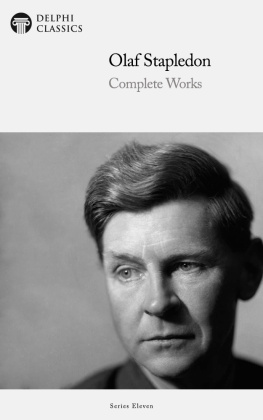
The Complete Works of
OLAF STAPLEDON
(1886-1950)

Contents

Delphi Classics 2021
Version 1


Browse our Main Series

Browse ou r Ancient Classics

Browse our Poets

Brow se our Art eBooks

Browse our Classical M usic series

The Complete Works of
OLAF STAPLEDON

By Delphi Classics, 2021
COPYRIGHT
Complete Works of Olaf Stapledon

First published in the United Kingdom in 2021 by Delphi Classics.
Delphi Classics, 2021.
All rights reserved. No part of this publication may be reproduced, stored in a retrieval system, or transmitted, in any form or by any means, without the prior permission in writing of the publisher, nor be otherwise circulated in any form other than that in which it is published.
ISBN: 978 1 80170 004 7
Delphi Classics
is an imprint of
Delphi Publishing Ltd
Hastings, East Sussex
United Kingdom
Contact: sales@delphiclassics.com

www.delphiclassics.com
Parts Edition Now Available!

Love reading Olaf Stapledon ?
Did you know you can now purchase the Delphi Classics Parts Edition of this author and enjoy all the novels, plays, non-fiction books and other works as individual eBooks? Now, you can select and read individual novels etc. and know precisely where you are in an eBook. You will also be able to manage space better on your eReading devices.

The Parts Ed ition is only available direct from the Delphi Classi cs website.
Try free Parts Edition downloads

Out-of-this-world classics
Explore Sci-Fi at Delphi Clas sics

The Novels

Seacombe, a district of the town of Wallasey, on the Wirral Peninsula, Cheshire Stapledons birthplace
Last and First Men (1930)

A STORY OF THE NEAR AND FAR FUTURE
Stapledon was educated at Abbotsholme School and Balliol College, Oxford, where he acquired a BA degree in Modern History (Second Class) in 1909, which was promoted to an MA degree in 1913. After a brief stint as a teacher at Manchester Grammar School, he worked in shipping offices in Liverpool and Port Said from 1910 to 1912. During the First World War, he served as a conscientious objector, acting as an ambulance driver with the Friends Ambulance Unit in France and Belgium from July 1915 to January 1919; he was awarded the Croix de Guerre for bravery. His wartime experiences influenced his pacifist beliefs and advocating of a World Government. He was awarded a PhD degree in philosophy from the University of Liverpool in 1925 and used his doctoral thesis as the basis for his first published book, A Modern Theory of Ethics (1929). However, he soon turned to fiction in the hope of presenting his pioneering ideas to a wider public. The relative success of his first novel prompted him to become a full-time writer.
A work of unprecedented scale in the genre of science-fiction, Last and First Men (1930) describes the history of humanity from the present onwards, across two billion years and eighteen distinct human species, of which our own is the first. The book employs a narrative conceit that, under subtle inspiration, the novelist has unknowingly been used as a means of dictation, channelling a text from the very last human species. The authors conception of history follows a repetitive cycle with many varied civilisations rising from and descending back into savagery over millions of years, as the later civilisations rise to far greater heights than the first. The novel anticipates the science of genetic engineering and is an early example of the fictional supermind a consciousness composed of many telepathically linked individuals.
Chapters 1 to 6 concern the First Men, our own species. Beginning in the early twenty-first century, several increasingly devastating wars take place in Europe, resulting in the United States and China becoming the two dominant superpowers on Earth. In the twenty-fourth century, the US and China go to war, which concludes with the formation of the First World State. Two centuries later, all religions and secular science consolidate into a religion based on the worship of motion, whose god is Gordelpus, the Prime Mover. Four millennia after the formation of the First World State, humans deplete Earths supply of fossil fuels, resulting in the total collapse of civilisation. One hundred thousand years later, the Patagonian Civilisation emerges as a cult of youth. When a riot occurs at a mine, the rioters inadvertently cause a colossal subterranean explosion, rendering most of the Earths surface uninhabitable for millions of years, except for the poles and the northern coast of Siberia. The only survivors of the disaster are thirty-five humans stationed at the North Pole, whose descendants eventually split up into two separate species.
The novel has come to be hugely influential in the course of science-fiction writing. Brian Aldiss, in his preface to the 1962 edition, acknowledges the considerable influence on his own later writing of Stapledons first novel, which he encountered in 1943 while a British soldier fighting the Japanese in Burma. Aldiss described it as, An appropriately unusual period of life at which to encounter a vision so far outside ordinary experience. C. S. Lewis in his own preface to That Hideous Strength , notes:
Next page






























